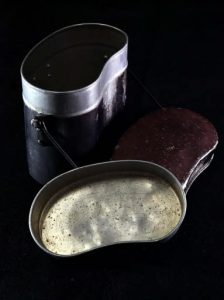Silent Witness: Mess kit salvaged from boarding house used to quench thirst of many victims
Dec. 16, 2019
by Yuji Yamamoto, Staff Writer
The mess kit, which glows dimly, belonged to Futoshi Tanimoto, 97, an A-bomb survivor who now lives in the city of Otake. Mr. Tanimoto salvaged the food container from a collapsed boarding house where he was staying in the Senda-machi area, present-day Naka Ward, about two kilometers from the hypocenter. The mess kit was used to ladle water and help quench the thirst of many victims who had suffered burns.
Mr. Tanimoto, 22 at the time of the bombing, worked at the Hiroshima plant of the Japan Steel Works, located in the city’s present-day Aki Ward. August 6, 1945, was a day off. When the atomic bomb detonated, he was on the second floor of the boarding house, which collapsed, trapping him underneath. He crawled out from under the debris, his body covered in blood. He fled to the athletic grounds of the Hiroshima University of Literature and Science (now, Hiroshima University), carrying with him a backpack containing the mess kit.
A large crowd had gathered around a hand pump. All the people’s clothes were tattered. They tried to drink water by cupping their burned hands but could only manage to take in small amounts. Mr. Tanimoto removed the mess kit from his backpack and handed its cover to one of the people standing in line. “Use this to drink,” he said. The person’s face was so swollen Mr. Tanimoto could not make out a facial expression.
Survivors took turns working the pump handle and handing the cover to the next person. Mr. Tanimoto filled the mess kit with water again and again, going around to injured people who were unable to move. The following morning, he found the cover lying neatly beside the pump. “I wouldn’t have been surprised had the cover not been there, but everyone was helping each other out.” Seeing the cover, Mr. Tanimoto could not hold back his tears.
Even after the war, he kept the mess kit at hand in the belief that it is filled with the emotions of so many. He donated the container to the Hiroshima Peace Memorial Museum 70 years after the atomic bombing, but the memories of that day are still fresh in his mind.
(Originally published on December 16, 2019)
The mess kit, which glows dimly, belonged to Futoshi Tanimoto, 97, an A-bomb survivor who now lives in the city of Otake. Mr. Tanimoto salvaged the food container from a collapsed boarding house where he was staying in the Senda-machi area, present-day Naka Ward, about two kilometers from the hypocenter. The mess kit was used to ladle water and help quench the thirst of many victims who had suffered burns.
Mr. Tanimoto, 22 at the time of the bombing, worked at the Hiroshima plant of the Japan Steel Works, located in the city’s present-day Aki Ward. August 6, 1945, was a day off. When the atomic bomb detonated, he was on the second floor of the boarding house, which collapsed, trapping him underneath. He crawled out from under the debris, his body covered in blood. He fled to the athletic grounds of the Hiroshima University of Literature and Science (now, Hiroshima University), carrying with him a backpack containing the mess kit.
A large crowd had gathered around a hand pump. All the people’s clothes were tattered. They tried to drink water by cupping their burned hands but could only manage to take in small amounts. Mr. Tanimoto removed the mess kit from his backpack and handed its cover to one of the people standing in line. “Use this to drink,” he said. The person’s face was so swollen Mr. Tanimoto could not make out a facial expression.
Survivors took turns working the pump handle and handing the cover to the next person. Mr. Tanimoto filled the mess kit with water again and again, going around to injured people who were unable to move. The following morning, he found the cover lying neatly beside the pump. “I wouldn’t have been surprised had the cover not been there, but everyone was helping each other out.” Seeing the cover, Mr. Tanimoto could not hold back his tears.
Even after the war, he kept the mess kit at hand in the belief that it is filled with the emotions of so many. He donated the container to the Hiroshima Peace Memorial Museum 70 years after the atomic bombing, but the memories of that day are still fresh in his mind.
(Originally published on December 16, 2019)








